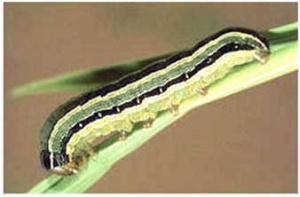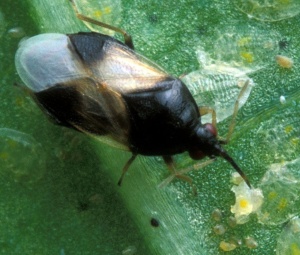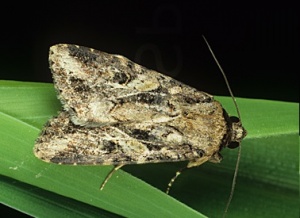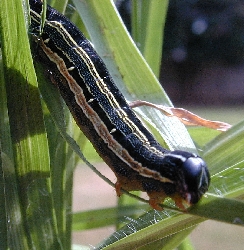Armyworm
African Armyworm - Spodoptera exempta


The African Armyworm (4 cm long) is also called Okalombo, Kommandowurm or nutgrass armyworm. It is the larval stage of a moth. It does well on wet conditions and do not proliferate in dry conditions. It has been observed in East Africa and African countries south of the Sahara, Saudi Arabia, Yemen, pacific islands, south-east Asia and Australia.[5] The moths are active at night. The larvae are active during daytime. The moths (av. 1.6 cm long, wingspan 3 cm) live about 10 days (5 to 16 days). One female maximally lays about 1000 eggs in total. During a pewriod of 10 days the eggs are laid at night in 2 or 3 batches of 10 to 400 in one or more layers on leaves or other surfaces. The egg mass is covered with down and black hairs from the female. The eggs hatch in 2–5 days. Larval stage lasts 14 to 22 days. Pupae are formed just below the soil surface in a soil cell. The pupal phase takes 7 to 15 days. In East Africa the total lifecycle lasts about 25 days at an average temperature of 26°C.[6] Within the Spodoptera genus, Spodotptera exempta is highly genetically diverse. One study revealed 17 different haplotypes within a single population of armyworms [7], with a size variation of approximately 115 to 153 kb. [8]
Population density
At high density (which may be up to 1000 per square meter) the caterpillars are black with yellow stripes. At low density, they are green or brown. They turn black when they are 10 days old. The larvae are not just darker, but also more resistant to baculovirus infection when reared at high density (gregarious form) compared to being reared singly (solitary form). This is due to elevated vertical transmission of infection in gregarious caterpillars. [9] The gregarious larvae have higher nitrogen conversion efficiency on an extreme protein-limiting diet, and accumulate more lipid per amount of carbohydrate consumed on carbohydrate-deficient diets.[10]
Temperature
Temperature dominantly affects larval and pupal development time, larval and pupal survivorship and pupal weight. The higher the temperature (34°C, 28°C or 22°C), the faster they grow. Survivorship in larval and pupal stage is generally lower at 22°C. Larvae reared at high temperature exhibit lighter coloration.[11]
Diet
The Spodoptera exempta larvae feed on all types of wild grasses (Poaceae) and sedges (Cyperaceae), and on early stages of grains. Their preferred grasses are sweet grasses in the genus Cynodon. They grow faster (and bigger) on well watered plants (80-90% moisture content) vs water stressed plants (60-70% MC). Survivorship is generally lower on water stressed plants in very young and older larvae.[12] The larvae posess receptors with sensitivity for specific sugars.[13] They prefer more carbohydrate over more protein.[14] But the opposite is true when virally or parasitically infected.[15]
High silica in grasses and sedges inhibits Armyworm growth. Seven of the ten most important food crops are silicon accumulators (up to over 10% in Wheat and 6% in ryegrass). The silica content of specific grasses (eg Bromus species, Elephant grass (Pennisetum purpureum) and Eustachys paspaloides) can be considerably higher than in many other plants. Silica levels are lowest in the stem fraction. The level of silica in grasses may co-depend on the level of silica in the soil, availability of water [16], the pH of the soil and temperature. Grasses adapted to hot climates and atmospheres low in carbon dioxide (C4 grasses), usually have lower silica contents than C3 grasses (cool-season grasses). There is no consistent relationship berrveen silica content and annual precipitation.[17] Water use per biomasse is lowest in regions with a high rainfall to evaporation ratio. Grasses that utilize water more efficiently, have lower silica contents. As a result, perennial C4 grasses such as Prairie cordgrass (Spartina pectinata), Switchgrass (Panicum virgatum), Big bluestem (Andropogon gerardii) and Prairie sandreed (Calamovilfa longifolia) contain relatively little silica. [18] Other perennial C4 grasses are Yellow Indiangrass (Sorghastrum nutans), White buffalograss (Panicum coloratum) and Bermudagrass (Cynodon dactylon), which is rare in Ghana, but abundant when present (up to 60 cm tall, does not tolerate shadow and prefers sandy, muddy and well drained soils. It is frequent in Mali, Ivory Coast and Nigeria. [19]. When supplemented, silica accumulation in Bermudagrass is high, but post-supplemental retention is low.[20] Bermudagrass may contain 0.15% slicia.[21]. Panicum coloratum (White buffalograss; a medium-high grass) may contain 1.21% silica.[22] It is drought-tolerant and does well in hot climates.
Grasses may also solubilize silicate from clay. [23] In perennial grasses, the main source of silica is from monosilicic acid (soluble silica) in the water. Silica levels in grasses are highly influenced by the monosilicic acid contents of the soil. As a result, clay soils result in higher silica contents in grasses than sand.[24] Silicification in non-grass species is probably less dependent on soil silica availability [25] and water availability.[26] .
The addition of silicon to the soil increases the size, shape, number and density of spines and phytoliths in the leaves of grasses.[27] And when defoliated by herbivores, silicate contents may increase 4-fold in response [28], but not nearly so much in grasses clipped with scissors.[29][30] Particularly in Africa the effects of grazing on silica contents are great, but not the effects of burning by fire.[31] Silica is deposited as phytoliths in leaves. These are harder than tooth enamel.[32] Phytoliths may also disrupt microbial action in the gut.[33] Spodoptera exempta cannot easily adapt to physical defences such as silica. Silica in the leaves of grasses (2-5% of dry leaf mass [34]) acts as a defence. Even with short-term exposure, but also progressively impacting with time, silica reduces the conversion efficiency of food into bodymass, and the amount of nitrogen absorbed from their food, leading to reduced growth rates. Exposure to silica-rich diets also caused an extremely rapid increased mandible wear.[35] This results in mechanical protection of resources in chlorenchyma cells. As a result of this (and of the disrupting influence of phytoliths on microbial action in the gut), less chlorophyll is released after grinding and more chlorophyll is retained after passing through the gut.[36]
S. exempta may also be succesfully reared on thin lamellae. (5 g. / individual, 60% survival)[37] or dried maize-leaf powder renewed at weekly intervals. (> 90% survival. At 25°C eggs hatched in 3 days, larval period was 12–16 days and pupal period 10-12 days.) [38] Rearing armyworm on a simple diet with milled good quality grass as the main diet constituent will not negatively affect fecundity of adults.[39]
Mass rearing


There is an annual Insect Rearing Workshop at the United States Department of Agriculture’s laboratory at Mississippi State University, organized by the entomology department. It was initiated by Dr. Davis and other experts who have over a period of more than 50 years developed an entire technology to breed large numbers of insects. During a week of lectures, labs and conversation, he and several colleagues pass on knowledge learned during a half-century of research, improvisation and hunch. The wisdom includes how to organize a lab to keep insects free of disease and contamination, how to create untainted artificial diets and when to add wild genes to keep a colony healthy.[40]
Armyworms may be used to rear Orius insidiosus and Agriosphodrus dohrni. The 2 cm long Assassin Bug (Agriosphodrus dohrni), native to China, India, Indonesia) may be reared (fed every 3 days) on yellow mealworms, in plastic cases, under a temperature of 23°C and RH of 50%.[41] The Assassin Bug may feed on all kinds of bugs, including aphids, beetles, hoppers', worms and caterpillars.


